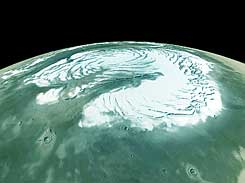Photographs have revealed that the south pole of Mars is melting

The south pole of Mars, covered by an ice cap made mostly of carbon dioxide
The mighty ice cap covering the south pole of Mars is shrinking. Since the dome is mainly made of frozen reservoirs of carbon dioxide (also known as "greenhouse gas"), the gas may melt and form a layer that will warm the frozen planet. This is how Mars may become a world where water flows.
The information about the contraction of the south pole of Mars is based on a comparison between photographs of Mars from 1999 and photographs from 2001. This is a period of time roughly equivalent to one year on Mars. All the photographs were sent from the NASA spacecraft - named "Mars Global Surveyor" - orbiting Mars.
The analysis of the photographs suggests, according to the researchers, that during this period depressions located at the pole expanded, while the hill ranges shrank. In addition, many of the small formations that were on the surface have completely disappeared. In fact, the change in the height of the surface route of the South Pole has been measured in the last two years by approximately 3-1 meters. These findings are published in the latest issue of the journal "Science".
According to the head of the research team, Dr. Michael Malin, who deals with planetary sciences, the significant reduction in the amount of carbon dioxide in the polar dome - as the photographs show - must lead to an increase in the amount of gas that will be released and reach the planet's atmosphere. If a large enough amount of carbon dioxide accumulates in the Martian atmosphere, it may prevent the sun's heat from dispersing into space, causing the planet to warm.
Today, the atmosphere surrounding Mars is thin, and consists mainly of carbon dioxide. The atmospheric pressure on Mars is approximately one hundredth the atmospheric pressure on Earth. Such pressure is essential to prevent evaporation and accumulation of water. According to Dr. Malin, if the melting of carbon dioxide from the ice at the poles continues at the current rate, this will lead to an increase in atmospheric pressure and an increase in the mass of the Martian atmosphere at a rate of about 20 percent every Martian decade (equivalent to about XNUMX years on Earth).
"Atmospheric pressure can be made high enough to allow water to flow near the surface - depending on the amount of frozen gas lying at the two poles," explains Dr. Malin. At the same time, the researchers said they are not sure if the process, which looks like global warming, represents a consistent and ongoing trend or a passing phenomenon.
One of the biggest challenges in the study of Mars is to find out if there was water on the frozen and desolate planet, and how it existed there. On the surface of Mars there are many features that suggest the flow of water in the past. This possibility has raised speculation that in a warmer and wetter past, Mars could have supported rudimentary life forms.
In an article commenting on the findings, Dr. David Page, a planetary scientist from the University of California, Los Angeles, says that the dynamic behavior of the polar caps on Mars and the exchange of carbon dioxide between the atmosphere and the surface can lead to results "on a global scale, and one day Mars may turn into bread and more humid".
Malin - who also founded the company that manufactured and operates the camera on the spacecraft - concludes based on the photographs that the climate on Mars is changing significantly even today. He believes that "even greater climate changes have occurred in recent centuries, and may occur again in the coming centuries."
